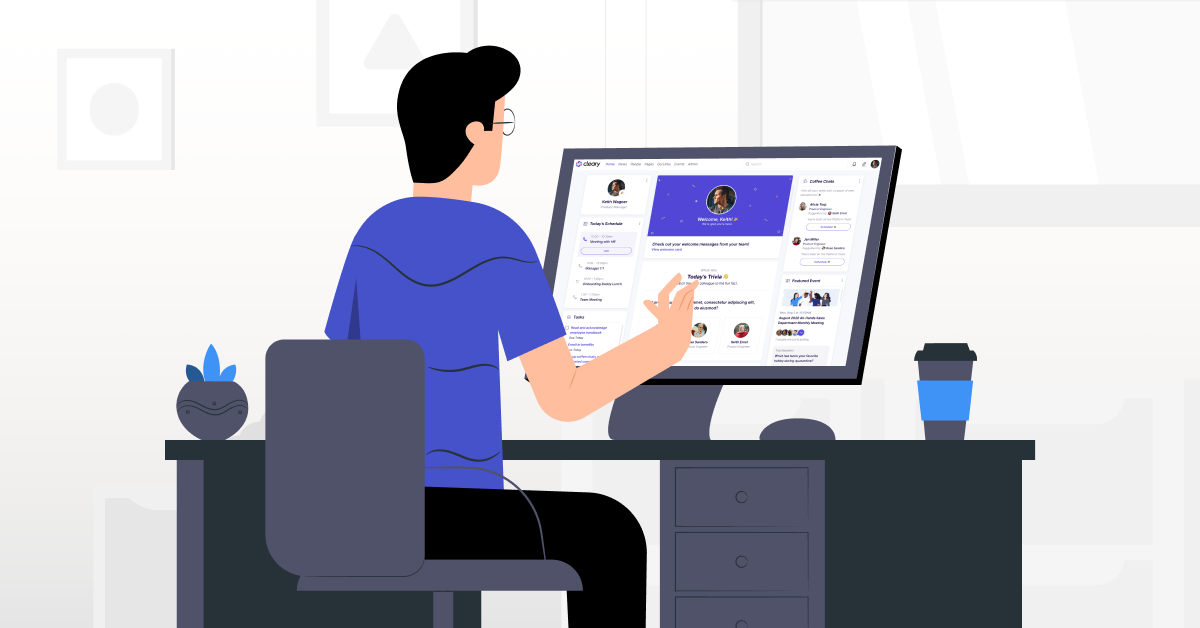According to Buffer’s State of Remote Work 2023, a decisive 98% of workers want to work remotely in their careers at least part-time. As this demand for remote work opportunities continues to transform traditional work culture, the pressure is on for employers to nail down an optimal hybrid framework that accommodates team members while still ensuring collaboration and continuity.
Despite the surge in hybrid work adoption—a trend that has seen a six-point increase since 2022 according to Deloitte—not all dispersed teams find their stride right off the bat and reap cross-functional rewards. As companies continue to navigate the WFH transition in coming years, building team resiliency in the remote work landscape remains foundational to both employee and customer experiences.
Today, we confront the primary challenges plaguing the hybrid workforce and examine how Cleary’s employee journey mapping (EJM) strategy helps turn the tide toward a more sure-footed and expansive approach to the employee lifecycle.
Decoding the Challenges
Though employee journey mapping is usually looped into an organization’s hybrid onboarding strategy, its benefits expand far beyond the realm of new hires. EJM provides invaluable insights into all stages of the employee journey – from preboarding to offboarding – serving as a pivotal tool for HR pros and other people leaders.
Three major challenges that can be identified (and subsequently remedied) through strategic EJM of distributed teams include:
Limited Visibility and Inconsistent Handoffs
Hybrid environments often suffer from foggy visibility of new hire progress during onboarding. Specifically, the transition from centralized HR oversight to department-specific management can introduce a lack of clarity for new hires. Without a unified view of onboarding milestones, HR, IT, and other people leaders can find themselves in a loop of communication just to confirm the completion of essential setup tasks.
By mapping out every handoff, check-in, and training step, EJM makes the hybrid onboarding process less confusing for new employees and less daunting for management to oversee.
Coordination Woes
In a hybrid setup, understanding who does what, when, and where presents a logistical challenge to team coordination. Prolonged disruption in company knowledge-sharing doesn’t just disrupt the flow of communication channels for dispersed teams but it impedes the creation of a cohesive digital office culture. In turn, these instabilities can worsen other internal comms concerns like information silos.
To support continuity of team productivity and interdepartmental communication, EJM helps leaders to visually piece together the workflow of employees in and out of the office, making it easier to synchronize on larger projects.
Stunted Company Culture
Bridging off the coordination woes that tend to weigh down distributed teams, company culture is a recurring pain point for hybrid organizations. With the dispersal of employees away from an office headquarters, remote workers can quickly feel disconnected from their in-office counterparts and unable to tap into a shared identity and community.
Along these lines, EJM doesn’t just aid in aligning schedules; it serves to align the individual experiences of employees with broader organizational values and goals over time. By intentionally outlining the employee journey to reflect what the company stands for, people leaders can ensure that every stage of an employee’s path reinforces a culture of engagement and recognition regardless of where they are based day to day.
Cleary’s Three-Fold Solution
Given the interconnected hurdles to the hybrid work experience on an operational, knowledge-sharing, and experiential level, Cleary’s approach to EJM is threefold. It creates an actionable framework on which leaders can comprehensively improve the employee lifecycle from all angles:
Operational Mapping
Operational mapping within EJM encompasses the logistical, paperwork-heavy side of work life, ensuring a standardized and transparent process for both new and tenured employees. This structured approach lays out clear progress indicators and provides all stakeholders with a centralized view of onboarding milestones, significantly reducing miscommunication and delays.
Knowledge-Sharing Mapping
This aspect of EJM addresses the vital need for a seamless information exchange. Cleary’s approach equips teams with a consistent knowledge-sharing infrastructure, vital for remote members to fully understand their role within the larger organization and to contribute effectively.
Experiential Mapping
Finally, experiential mapping recognizes the individuality of each employee’s journey. By tailoring experiences to meet personal preferences and needs, this facet of EJM cinches engagement and satisfaction, which are crucial for the long-term retention of remote employees and the solidification of a culture of belonging.
The Journey Forward
Employee journey mapping offers a true transformation of organizational culture and allows companies to execute more wide-scale advancements in the employee experience. It also avoids any micromanagement concerns by allowing hybrid workers to lock into personalized workflows, cutting back on the need for excess check-ins and digital noise.
Specifically, Cleary’s elevated take on employee journeys helps keep all team members in the know with customizable step-by-step modules viewable by designated admins. With built-in progress tracking, journey templates, and feedback features, Cleary’s streamlined hub for EJM allows employees and managers alike to always be focused on the journey forward instead of constantly circling back.
In this light, EJM is not only about adapting to the ever-changing professional landscape but also about proactively shaping it. It ensures that all team members feel seen, appreciated, and integral to their organization’s mission. Through an ingrained commitment to fostering a more holistic employee experience, Cleary helps hybrid companies unlock the potential of more unified and resilient teams.




